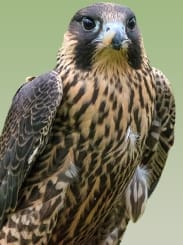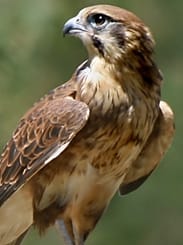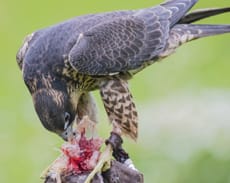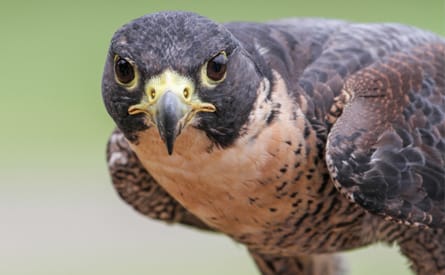


Peregrine Falcon (Falco Peregrinus)
Proving date: 1997
Proving completed by: Misha Norland & The School of Homeopathy
Common name : Falcon
Download: Full proving Falcon (Falco Peregrinus)
Download: Proving rubrics
About the Peregrine Falcon
Violent rages of wilfulness in the face of opposition.
A stirling remedy for patients who feel constrained and dominated, especially by a parent or partner, or even their own children. They may feel like a trapped wild animal, forced to do things against their instinct for survival, as if towered over by an overwhelming power that they are forced to obey.
On the positive side, there is brightness, clear-sightedness, focus, single pointedness, laughter, confidence, a major 12 noon modality, closeness to nature, colours, spiralling and speeding. The negative side shows signs of coldness and unfeeling anger especially towards loved ones and even to their own children and indeed anyone perceived as posing a restraint. There may be a perception of being put down, humiliated, scorned, undervalued, even menaced, frightened, trapped and powerless. Internal conflict arises due to a desire to please or do one’s duty versus a refusal to be restricted. Going off sex is a passive way of fighting back. One prover reported that she had become the 'Ice Queen'. Human life to Falcon may seem cheap, impoverished and dirty, and the raptor provings have all generated this sense. Some provers wanted to waste resources or squander money, while most developed an sympathetic response to nature especially towards endangered environments and the disempowered. There may be issues around feeding with anorexia, gluttony in private, and secret addictions.
Falcon
The peregrine falcon, also known as 'The Noble Bird' is one of 38 species of raptor in the genus Falco, and is widely spread around the World. There are several features that distinguish falcons from other raptors – they do not build nests (falcon 'nests' are called eyries) and instead lay their eggs in 'scrapes' (small dips created by the birds scraping the rock surface) on natural ledges, cliffs, high buildings, holes in trees and even on the ground. Falcons have proportionally longer and narrower wings than eagles and hawks, they kill by talons in high-speed impact or with their beaks, and have exceptional vision. The falcon is black-brown with a yellowish-white breast and rust-red streaks. The tail has horizontal black stripes. The bird has distinctive facial markings with a black 'moustache' around the eyes. The feet and talons are large and bright yellow, as is the protuberance at the base of the bill. The thin tapered wings enable it to change direction rapidly, to chase its prey, and to fly at exceptionally high speeds. The bird usually climbs above its prey, then power dives on to it at up to 200 mph. This makes it by far the fastest creature on Earth. Favourite prey is pigeon and, if the prey is not killed by the shock of being hit at such great speed, it receives a bite to the neck on landing. Falcons have a 'tomial tooth' – a projection on the upper beak with a corresponding notch on the lower one – that allows them to kill their prey immediately. The prey is plucked and broken up, then eaten or taken to the nest for the young. The birds usually hunt in the early morning and again in the evening but, if there are young to feed, may spend most of the day hunting. 2–4 eggs are laid after courtship, and the female incubates them for about 4 weeks. Chicks take about 6 weeks to develop and for the first few weeks the female stays with them. The male brings food close to the nest and passes it to the female in mid air, talon to talon. Fledglings stay close to the nest for another 5–6 weeks while they learn to fly and hunt, and are then chased from their parents' territory. Not yet proficient in hunting, many juveniles die of starvation in their first Winter. The young birds tend to adventure further afield during Winter months but usually return to the same area to breed.
Mythology
Symbolism: of falcon is about success, victory and power to rise above a situation. North American Indians believe the falcon is a messenger that brings us guidance from the spirit world. The Ancient Egyptians believed it brought the sun in the morning and dragged it away in the evening. In Egyptian mythology, the falcon finds its most powerful expression in Horus. Images of Horus are chiselled at the top of all Ancient Egyptian obelisks where it appears in its role as god of kingship and the sky. Horus is depicted with one eye as the sun and the other as the moon, thus containing and appeasing the opposites. In European tradition the falcon represents the hunt and huntsman, and arose as a symbol during times of the war.
History
Derivation of the name: Falcon derives from the Latin 'falx' (sickle) and alludes to the sharp beak that, like the grim reaper, brings sudden death. Peregrine comes from the Latin 'peregrinus' (strange or foreign). This term was used for non-Roman citizens living in Rome and was applied to pilgrims.
Hawking and falconry: [1] Hawking uses short-winged birds (hawks) launched from the fist when the quarry is sighted. Their power and manoeuvrability allow them to capture prey on, or close to, the ground. [2] Falconry uses long-winged birds (true falcons) let slip to climb high before the quarry is put up. They stoop at such speed, taking the catch in mid air, that to take the prey on, or close to the ground, would be dangerous.
Sport: Hunting with birds of prey probably started more than 4,000 years ago. The earliest record is a Hittite carving from the 13th century bc in which a child is holding the leash of a jessed falcon. There is evidence that the Assyrians were keen falconers but the Egyptians, perhaps as a result of their devotion to Horus, never took up falconry. The Greeks and Romans were also not taken by the sport though it was popular among the Gauls and Celts. The sport was important in the Middle East and lasted through the Middle Ages and the Renaissance, reaching its apogee in the reign of Louis XIII. The French Revolution saw the end of falconry as the sport of kings in Europe. Oriental falconry has a similar history – it was part of the Samurai world in Japan and was widespread in India and Central Asia. Today only some of the Arabian princes carry it on as a Royal Art but in many countries there remain small numbers of committed falconers and hawkers.
The hunt: A dog is used to 'point' the position of the quarry while the falcon is let slip and given time to climb. When the bird is in position, the quarry is put up and the falcon stoops at great speed, killing or stunning it. The falcon brings the prey to the ground and mantling, it begins to plume it. The falconer approaches quickly while the bird is engrossed and if he offers a lure of fresh meat, the falcon will instinctively take it, thereby allowing the bird to be caught by its jesses. Jesses are always worn, even when the bird is in flight. The falcon is given a small part of the kill, the 'faire courtoisie'.
Training: A bird of prey is never domesticated. The learned response to the lure and the sound of the whistle will usually call back the bird but if it were to fly out of sight or hearing it would be free. It is always fed by the falconer and wears large hacking bells to prevent it from taking its own prey. The jesses can be attached to a leash, to prevent the bird from flying off. The bird is left tethered in semi-darkness without food until it is exhausted and starving when it is offered a morsel of meat on a gloved fist or lure (doughnut shape of padded leather with birds' wings on either side to which meat is tied, in the centre). The lure is swung in a circle on a piece of cord and whenever the bird is offered food, a distinctive whistle is sounded. Driven by hunger, it will come to the glove or lure to take the meat, gradually getting used to being fed this way, and being carried around. Hawks are always fed on the fist whist falcons are called to the lure. If a bird is too heavy it will not be hungry and not especially interested in hunting thus less likely to return when called. If it is too light it will be hungry but may be too weak to hunt properly. The experienced falconer will know his bird's ideal weight and will feed it to achieve an optimum weight when he wants to fly it. The wild falcon dismembers its prey away from the nest site, so as not to attract scavenging predators to the whereabouts of the chicks. From patients point of view, there may be issues around feeding, including anorexia, gluttony in private, and all manner of secret addictions.
Hood: When the bird is used to people, dogs and being fed, it is introduced to the hood. The hood fits over the falcon's head and is used for transporting and to prevent distraction during the hunt. Training continues with the falcon on a gradually lengthening leash until the falconer is confident the bird will return on being called, flying freely.
World War Two: Historically, pigeon fanciers have carried a powerful hatred for the bird. During WW2 carrier pigeons were an important means of communication but were favourite meals for falcons along the south coast of Britain. Worried that they were losing valuable messages, the RAF ordered a massive cull and over 600 birds were killed during the war. Given that there were about 1,100 pairs of birds in the entire country it was a big cull but numbers recovered surprisingly quickly.
Pesticide use between the 1950s and 1970s: In 1961, English pigeon fanciers claimed the peregrine falcon population was getting out of hand. The government commissioned a study that demonstrated otherwise – numbers had in fact fallen dramatically as a result of pesticides, especially DDT that was identified in the tissues of dead birds and broken eggs. It was shown that DDT affects calcium levels and eggshells became thin enough to break under the weight of the brooding mother. The decline of falcons occurred worldwide and these birds became extinct in the vast forests of eastern Europe and completely disappeared from the eastern side of North America. Worldwide recovery work and widespread restriction of DDT use, restored the British peregrine falcon population fairly rapidly but numbers have been much reduced worldwide, being completely wiped out in some areas. The realisation that these chemicals could cause such damage led to an awareness of ecology and the birth of the green movement.
The proving
There is a prologue to the proving that is worthwhile mentioning. Patient X, after receiving homeopathic care, had become director of a charity that provided homeopaths for projects in developing countries. She had felt increasingly hemmed in at work, while others, being funded by her efforts, were setting up homeopathic care projects. During this time her tormentor – her father – reappeared, stalking her. Menaced by fear, wanting to escape, yet bound by obligation to the charity, she consulted Misha again. He could find nothing new except an intensification of her state for which AIDS 200c had been prescribed previously. Although repeated, it had not continued to act as before. Misha remembered X's love of running and climbing the rugged rock face. An image came before his mind's eye – a picture of training the falcon, which involves starvation, being tied by the ankles and kept prisoner in a dark place. He thought of the perverted bond of persecutor and victim – the 'no escape' situation of the bird until, once trained, it is allowed its flight, yet returns when summoned by conditioned reflex to whistle and lure. Mentioning his ruminations to X, led to an interesting revelation that she knew a vet who ministered to an aviary of hunting birds! Thus, the source was procured, and sent to Helios Homeopathy. The pharmacist provided a report of her experiences – the first proving – while X greatly benefitted from the dose. She lost her fear, sense of disempowerment, quit the charity and is currently living in her beloved Scotland where she can roam carefree, making her peregrinations.
A small piece of feather and a sample of blood were taken from Nesbit – a 2-year-old captive-bred peregrine tiercel – by his regular vet, and used as the substance. Nesbit had been acquired when a very young eyass and had been brought up in his owner's home. Even for a peregrine, he is a bird of considerable character and charm. Nesbit had never experienced unrestrained flight, being confined to his enclosure. These themes emerged in the proving as the miserable bond between persecutor and victim. There was also unfeeling anger with irritability, detachment and swearing. One prover reported they had become the 'Ice Queen'. Provers described symptoms of menace, scorn, clear-sightedness, focus, humiliation, and being undervalued. Most felt elevated, uplifted and childlike early in the proving. There were experiences of floating and flying, and provers felt close to nature. And like the bird, there were spiralling preoccupations for many, with waves and a sense of bobbing up and down. The group is an important aspect of the remedy, and after the proving dose had been taken, 7 of the group (2 male), came to class with painted finger nails – emblematic of the falcon's death-delivering talons!
Download: Full proving Falcon (Falco Peregrinus)
Download: Proving rubrics

Spirals - Carefree - Floating - Childlike - Group - Nature - Clear - Swearing - Ice Queen - Hemmed in - Scorned - Miserable
Proving Themes
Kingdom: Animalia
Phylum: Chordata
Class: Aves
Order:Falconiformes
Family: Falconidae
Subfamily: Falconinae
Genus: Falco Linnaeus, 1758
Kingdom Taxonomy
The Falcon's flight takes the form of a series of rapid strokes of the wings followed by a short glide. It usually climbs above its prey and then dives on to it. This dive is called the "stoop" it is variously estimated from a hundred to two hundred miles an hour. Whatever the case may be the Peregrine Falcon is the fastest creature on earth.

.jpg)

